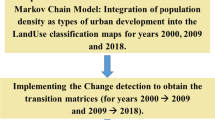Abstract
Regional Niagara is the site of an intense three-way land-use conflict among urban, agricultural and natural uses. Large scale spatial and temporal land-use data were used to investigate the dynamics of land-use change in this area. A first order Markov chain was used as a stochastic model to make quantitative comparisons of the land-use changes between discrete time periods extending from 1935 to 1981.
The Markov model allowed for two main conclusions about the historic dynamics of land-use change in the Regional Municipality of Niagara.
-
1.
The urbanization of agricultural land was the predominant land-use change.
-
2.
A continuing ‘exchange’ of land area occurs between wooded and agricultural land-use categories that has little effect on the net amount of wooded land but which could undermine the long-term ecological value of remaining natural areas in Niagara.
Similar content being viewed by others
References
Bell, E.J. 1974. Markov analysis of land use change - an application of stochastic processes to remotely sensed data. Journal of Socioeconomic Planning Sciences 8: 311–316.
Bourne, L.S. 1969. Forecasting Land Occupancy Changes Through Markovian Probability Matrices: A Central City Example. Research Report No. 14. Centre for Urban and Community Studies, University of Toronto, Toronto.
Bourne, L.S. 1976. Monitoring change and evaluating the impact of planning policy on urban structure: a Markov chain experiment. Plan Canada 5–14.
Khan, J.R. 1980. Agricultural land use changes in southern Ontario 1867–1951. Geographic Review of India 42(4): 342–354.
Krueger, K.K. 1959. Changing Land-Use Patterns in the Niagara Fruit Belt. Department of Geography, Indiana University, Gary, Indiana.
Krueger, K.K. 1982. The struggle to preserve specialty crop land in the rural-urban fringe of the Niagara Peninsula of Ontario. Environments 14(3): 1–10.
Krushelnicki, B.W. and Bell, S.J. 1989. Monitoring the loss of agricultural land - Identifying the urban price shadow in the Niagara Region, Canada. Land Use Policy April 1989: 141–150.
Niagara Region Review Commission. 1989. Report and Recommendations of the Niagara Region Review Commission. Queen's Printer for Ontario, Toronto, Ontario.
Preservation of Agricultural Lands Society (PALS). 1988. Niagara Conservation Strategy. Standard Fine Printing, St. Catharines, Ontario.
Regional Municipality of Niagara. 1988. Regional Niagara Policy Plan - Office Consolidation. Regional Municipality of Niagara, Thorold, Ontario.
Rowe, J. 1977. The Forest Regions of Canada, Canadian Forestry Service, Ottawa, Ontario.
World Commission on the Environment and Development. 1987. Our Common Future. Oxford University Press, Oxford.
Author information
Authors and Affiliations
Rights and permissions
About this article
Cite this article
Muller, M.R., Middleton, J. A Markov model of land-use change dynamics in the Niagara Region, Ontario, Canada. Landscape Ecol 9, 151–157 (1994). https://doi.org/10.1007/BF00124382
Issue Date:
DOI: https://doi.org/10.1007/BF00124382




